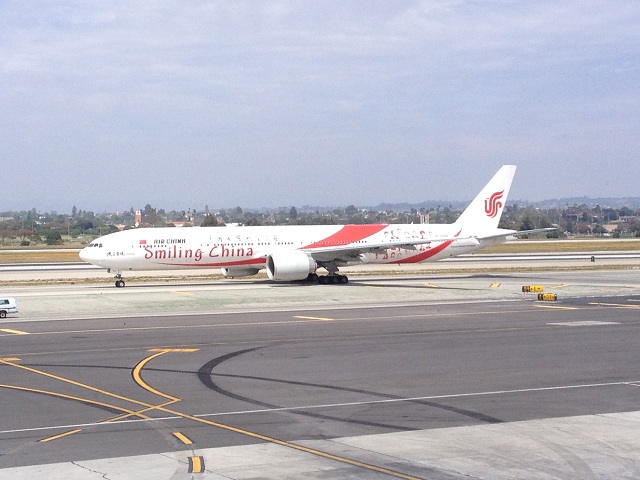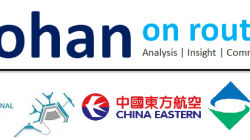
Air China will commence four weekly flights to Newark airport from its Beijing – Peking hub on October 26, 2015, utilizing its 777-300ER fleet to operate the 6,931NM distance between the two cities in each direction. The Newark station will complement Air China’s existing nonstop services from Beijing to New York JFK, although schedules loaded into the GDS system appear to indicate that Air China will be reducing its New York JFK frequencies from 14 to 11 weekly during the winter period in 2015-2016, leading to an ultimate net gain of 1 additional weekly flight to the New York City region.
Air China’s Newark flight will compete with United’s daily nonstop service from Newark to Beijing, which United inherited from its merger with Continental Airlines. Beijing represented Continental’s inaugural service from the United States to mainland China when it launched Newark – Beijing flight in 2005, followed later by a Newark – Shanghai nonstop flight in 2009.
The Newark schedule will follow a similarly-timed departure and return to Beijing as United’s flight, with a mid-morning same day departure from Beijing and arrival in Newark, and a noon return departure from Newark and mid-afternoon arrival in Beijing the following day.
CA819 PEK0935 – 1005EWR 77W x357
CA820 EWR1225 – 1455+1PEK 77W x357
Air China runs a similar schedule from New York JFK, although with a later afternoon departure from Beijing and return from New York. Air China uses a mix of 777-300ERs and 747-8Is on its New York JFK flights, representing the newest additions to its long-haul fleet.
CA989 PEK1000 – 1030JFK 77W x124
CA981 PEK1300 – 1330JFK 74H D
CA990 JFK1250 – 1540+1PEK 77W x124
CA982 JFK1550 – 1820+1PEK 74H D
Air China has deepened codeshare ties with Star Alliance, including United
It is salient that Air China has chosen to compete head-to-head with United on a route where, in theory, there should be a degree of cooperation given that both carriers are members of Star Alliance. Although the relationship between the two airlines has been passively neutral since Air China joined Star in December 2007, there has been movement on that front. Air China and United are codeshare partners and recently announced an expansion of their agreement in June 2015. Air China places its code on several domestic U.S. flights operated by United from its hubs in Houston, San Francisco, Los Angeles and Washington Dulles, while United has also placed its code on a series of domestic Chinese routes from Beijing and Shanghai.
Although the relationship may be growing, it is still miles behind Air China’s proposed joint venture agreement with the other major North American Star Alliance carrier – Air Canada – where both airlines intend to have a full revenue-sharing system in place by the end of 2015. In conjunction with this agreement, Air China plans to launch thrice weekly Beijing – Montreal flights on September 29, 2015. The route was purportedly to operated with a continuation service to Havana from Montreal, but details on that development have been sparse and the plans have likely been shelved for now as Air China does not have 5th freedom rights to fly between Montreal and Havana.
Air China has embraced deepening ties with fellow Star Alliance members, likely keeping a close eye on neighboring All Nippon Airways for its highly successful joint venture agreements on North America – Japan services and Europe – Japan services. All Nippon participates in a “J+” bilateral joint venture with Lufthansa, including LH Group members SWISS and Austrian, on nearly 200 weekly flights between Japan and Europe. All Nippon has also benefitted from a transpacific joint venture agreement with United Airlines on routes between the U.S. and Japan.
In addition to its ongoing JV implementation with Air Canada, Air China also expects its proposed JV with Lufthansa to fully materialize by the end of 2015 as well. Air China also has proposed a special alliance with Air New Zealand, although this will be much smaller in scope.
Air China has been proactive in expanding to the U.S. – with success
It is unclear whether Air China will add additional codeshare routes out of Newark on domestic flights operated on United metal, but it may not be necessary given that Newark provides a large O&D component as one of the major two international airports serving the New York region.
Interestingly, Air China launched nonstop services to Washington Dulles airport last year, which also began as a less-than-daily operation in addition to United’s daily nonstop Washington – Beijing flight, which has been in operation since 2007. Air China’s Dulles operation has remained at 4-weekly, 5-weekly during the peak summer. Air China also added service to Houston Intercontinental in 2013, a market that had previously offered no nonstop service to mainland China or anywhere in Asia outside of Tokyo. Houston was presumably profitable, “out of the box” for Air China, but other carriers have caught on to the market potential in the petroleum city as Korean Air, EVA Air and All Nippon Airways have all launched service to Houston in the past year.
Related: Houston continues growth to Asia with additions of ANA and EVA Air in 2015
In addition to Houston, Washington D.C., New York JFK and soon-to-be Newark and Montreal, Air China also serves Honolulu, Los Angeles, San Francisco and Vancouver in the North America region.
It is not uncommon for two foreign flag carriers to serve both international airports in New York – Newark Liberty and JFK. Cathay Pacific is a noteworthy example of a carrier that recently expanded further in New York by adding a 5th daily frequency to Hong Kong – except opting to launch this particular flight from Newark instead of JFK. Presumably, the logic behind Cathay’s move to launch Newark was to back-fill some of the demand left behind when Singapore Airlines discontinued its nonstop flight in late 2013 to EWR. Moreover, Cathay intended to transport passengers from Newark to Hong Kong and beyond rather than tailor solely to O&D traffic.
Similar logic could apply to Air China’s intentions to launch Newark service in addition to JFK. For all intents and purposes, Air China – as well as its three primary state-owned Chinese competitors, China Eastern, China Southern and Hainan – are all larger than U.S. carriers in terms of seats per week offered each way between the U.S. and China (although this apparently is not the case during shoulder season).
Even still, Air China has several advantages over its U.S. (and even Chinese) counterparts: a large government backing from Beijing as the preferred “foreign flag” carrier for China, a huge local market in Beijing, with a secondary long-haul hub in Shanghai, and the ability to tap into a much larger local market from mainland China (and beyond Asia). The growth in Chinese tourists abroad has spurned the traditionally lethargic Chinese carriers to tailor to demand in growing nonstop services, especially with faster visa processing times, growing wealth among the Chinese middle class, and liberalized air transport access to foreign markets.
Secondary Chinese markets are also in the pipeline: has the U.S. missed the boat?
Needless to say, of all the competitors in the U.S. – China nonstop market, Air China’s expansion in the U.S. has been the most aggressive, with the distant #2 carrier being Hainan Airlines, also based in Beijing.
Usually not privvy to the same privileges that fellow state-owned carriers receive, Hainan has employed other strategies to grow its long-haul network from mainland China to destinations abroad. The carrier secured nonstop flights to Seattle, Boston, Toronto and Chicago, and recently launched services to San Jose, CA. These are strategic gains given that China tends to allow a “1 carrier, 1 route” policy to Chinese airlines wishing to operate long-haul routes (Air China has been given some notable exceptions to this rule).
Now, Hainan has embarked on a newer strategy to continue its long-haul expansion in the Americas, but intends to add service from existing stations to other long-haul markets in China, such as Boston/Seattle – Shanghai, as well as launching nonstop service to secondary Chinese cities from markets effectively, “blocked” by Air China. For instance, Hainan intends to launch Los Angeles – Changsha services, as well as New York JFK – Tianjin and Vancouver – Tianjin services sometime in 2016. Although considered “back-door” entrances to access primary markets, Hainan has two advantages on its side: the large local outbound Chinese market, and possible aid in the form of airport subsidies and incentives for Chinese airports absent of long-haul flights.
Meanwhile, fellow Chinese carriers China Eastern and China Southern have been sluggish with little additional growth to the U.S., while U.S. carriers face their own hurdles that have impeded U.S. – China growth. Of the three major U.S. airlines, United is the largest transpacific operator, and while its service from San Francisco to Chengdu in 2013 was considered novel at the time, there has been little indication that United will add additional secondary cities in China. The carrier has opted to deploy its 787 aircraft on existing long-haul routes rather than create new ones.
Delta and American do not currently serve any secondary cities in China. Delta has been focusing its Asian growth out of Seattle while also desperately seeking to grow its partnerships with fellow Chinese SkyTeam members China Eastern and China Southern, which has been negatively perceived by SkyTeam founding member Korean Air.
American, on the other hand, is playing catch-up relative to the other two airlines, having just recently secured rights to operate nonstop service to Beijing, Hong Kong and Shanghai from its global DFW hub. However, if American plays its cards right, further opportunities from Los Angeles could be a huge boon for the carrier, especially as more 787 aircraft is delivered.
The major hurdle which all three U.S. carriers face in the U.S. – China market is not the Chinese market itself, but rather, their prior tie-ups with Japan and Japanese Airlines as all three carriers have hub operations in Tokyo. Balancing stability in Japan, despite pressure from the Yen and weakened economy, with a desire to open new over-Japan flights to China comes with careful precision. United’s JV partnership with ANA and American’s with JAL are extremely strategic and important to both of their networks. Delta, too, has a storied history in Japan and having a scissor hub operation in Tokyo, although it has been much more vocal about the disadvantages it faces at Narita airport without a local partner and limited connectivity options to other Asian markets.
There may still be time for U.S. airlines to catch up to growth from China – but so far, its clear that a winner has emerged. Moreover, without Open Skies agreements, U.S. and Chinese carriers cannot pursue joint venture agreements. Until such a possibility is in the realm, U.S. airlines may not be capitalizing on opportunities that are on the table.

